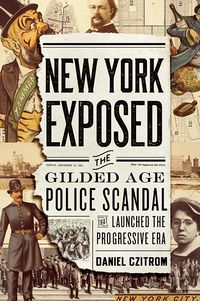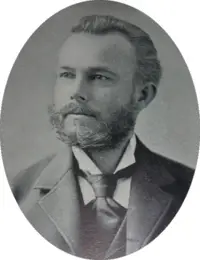Why was it difficult to punish the police for brutality during the Gilded Age
by Daniel Czitrom author of New York Exposed: The Gilded Age Police Scandal that Launched the Progressive Era (Oxford University Press, 2016)
Every day seems to bring another story documenting the persistent police brutality and routine harassment endured by minority citizens in too many American cities, from New York to Baltimore to Cleveland to Ferguson. A recent report from Chicago’s Police Accountability Task Force lays out in depressing detail the grim realities of institutional racism that have plagued that department for decades: physical and verbal abuse, unjustified stops and arrests, cruelty in some station houses that can only be described as torture. The current racial dynamic has been familiar since at least the 1950s. But earlier controversies around police misconduct, even though they did not revolve around racial discrimination, underscore the historic difficulties associated with reigning in and punishing police misconduct.
Over a century ago, in 1894, the first sensational political investigation of the modern era revealed in shocking and unprecedented detail how the police force managed New York City’s lucrative vice economy, extorted payoffs from respectable businesses, and enjoyed near-total immunity from charges of police brutality. Established by the New York State Senate, the so-called Lexow Committee heard public testimony from nearly 700 witnesses, representing all walks of New York life.
The Lexow Committee
The investigation included an unprecedented inquiry into police violence against individual citizens, brutality that always went unpunished. On October 2, 1894 investigation chief counsel John W. Goff presented a startling sight that put human—and battered—faces on police immunity from the law. In what the Times described as “a spectacle without parallel, as amazing as it was unique,” Goff summoned ninety uniformed policemen to appear, each of whom had been convicted by the Police Board of Commissioners over the past three years for brutality. Many of their victims, some of them bandaged and bloodied, were present as well. A long procession of cops told how the Police Board had found them guilty of clubbing, punching, kicking, or choking citizens, only to be fined a few days’ pay. None had been dismissed from the force. The entire day’s testimony, Goff declared, “goes home to the very question of the rights, the liberties, and the safety of the citizens of New York.” The accumulated weight of the day’s display, the Morning Advertiser concluded, demonstrated to the world that “New York has the most brutal police force on the earth.”
This public exhibition on brutality—victims, perpetrators, and the impunity they enjoyed—could only scratch the surface. Immigrant Italians and Jews, and poor people generally, suffered the brunt of police violence. There were many cases deemed too shocking for open hearings, but they were notorious in the tenements and streets of the Lower East Side and other neighborhoods. In one 1891 case never made public, a patrolman was tried and found guilty by the Police Board of a “crime against nature”: raping a 14-year-old boy in a Monroe Street tenement. As punishment, the Board fined him three days’ pay, a total of $8.21; the cop remained on the force and never faced any criminal charges.
The investigation framed the question of police brutality purely as a by-product of corruption, a symptom of a police force that saw itself as above the law. The greatest outrage was reserved for police clubbings of respectable citizens on the street or at public events. Yet the investigation never addressed the most widespread practice of Gilded Age police brutality: the direct role cops played in crushing strikes by clubbing strikers and their supporters, protecting scab labor, and spying on unions. As class conflict intensified during the 1880s, growing more violent across the city and the nation, political and business leaders routinely unleashed the police to violently suppress unions and political dissent.
NYC Police Brutalize Protestors and Marchers
In March 1886, for example, drivers and conductors on the Dry Dock streetcar line, desperate to reduce their workday to 12 hours and raise their daily wage to $2, went on strike. The company president immediately asked Police Superintendent William Murray to intervene. On March 4, thousands of angry strikers and their supporters filled Grand Street from river to river, determined to prevent the running of any Dry Dock streetcars. Murray stationed 500 policemen along the street and personally commanded another 250 to accompany a lone horsecar from its East River stable across Grand Street to the Hudson, and back. Demonstrators blocked the tracks with overturned carts, ash barrels, and paving stones, while rocks and eggs rained down on the police from tenement windows.
When they reached Allen Street, Murray suddenly yelled, “Charge!” and instantly hundreds of clubs came down on the heads and shoulders of everyone in sight, including well-dressed bystanders and women shoppers. The beatings and street fighting continued for over two hours as the car completed its purely symbolic round trip. Two days later some 15,000 drivers, conductors, and stablemen from other car lines walked off their jobs in a sympathy strike, tying up the city’s entire transportation system. The companies soon broke the union drives through indictments of union leaders and the continued massive police intervention.
One might date the racialized police brutality so familiar today to August 1900 and one of the worst race riots in New York City history. On an Eighth Avenue corner in midtown, an African-American man challenged a plainclothes cop over the arrest of his girlfriend for “soliciting.” A fight resulted in the stabbing and death of the policeman, triggering a wild night of rioting, as thousands of whites poured onto Eighth Avenue, chasing and beating blacks wherever they found them. Scores of policemen joined the street mobs, clubbing blacks and refusing to go after their attackers. It was a long way from the Draft Riots of 1863 when police stations offered refuge for the victims of racist violence. Prominent African Americans organized a Citizens’ Protective League to gather evidence and press claims against the NYPD.
Yet despite a massive amount of eyewitness testimony, an official investigation by the Police Department itself whitewashed the entire affair. Not a single policeman faced any riot-related charges. The racial dynamic is of course different than in the 1890s—although the Lexow inquiry revealed an ethnic/racial component in the regular police abuse of Jews, Italians, and other poor immigrants. And police repression of labor unions and political radicals, though occasionally still with us, is no longer understood as central to the “police power.”
Conclusion
Yet one underlying dynamic connects Gilded Age era police abuses to those of the present: the extreme reluctance of prosecutors and grand juries to punish cops found guilty of abusing their authority. After the Lexow revelations, some forty police officers, including an inspector and fourteen captains (nearly half of the department’s total) faced indictments on charges of bribery, extortion, and neglect of duty. Many of these cases had dragged on for years.
But by 1897 not a single New York police officer was in jail and all the men dismissed from the force had won reinstatement with back pay. The courts consistently held that evidence supplied by persons of “disorderly character” was insufficient for conviction of bribery or extortion. The use of body cameras, the creation of civilian complaint review boards, and the evidence provided by witness cell phones—none of these will improve the current situation without a new commitment to apply the law firmly and consistently to rank and file cops and police officials.


